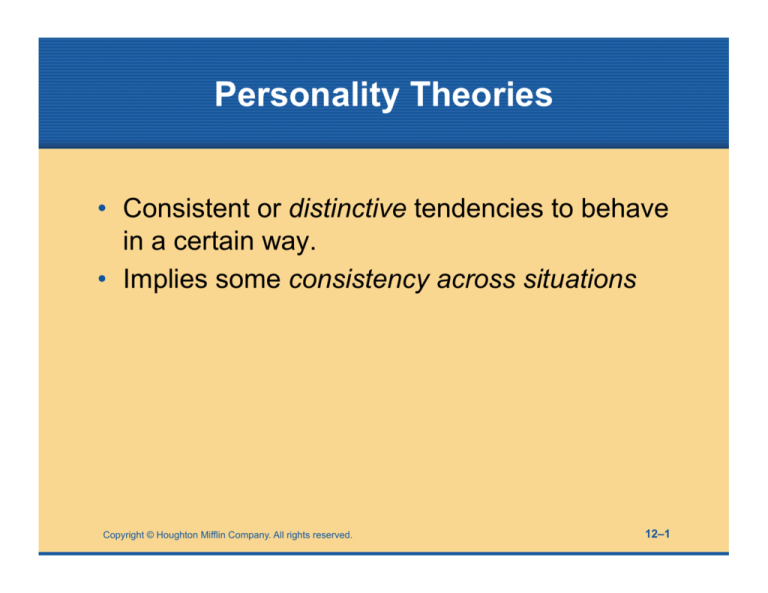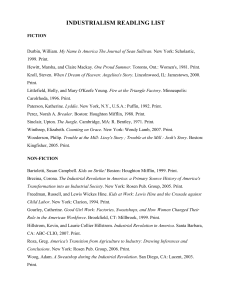
Personality Theories
• Consistent or distinctive tendencies to behave
in a certain way.
• Implies some consistency across situations
Copyright © Houghton Mifflin Company. All rights reserved.
12–1
Psychoanalytic Theory
• Developed by Sigmund Freud
• Importance of instincts
– Sexual instinct
– Aggressive instinct
• Instincts must be balanced with social
acceptability
Copyright © Houghton Mifflin Company. All rights reserved.
12–2
Levels of Consciousness
(Figure 12.1)
Psychoanalytic Theory:
Structure of Personality
• Id
– Unconscious drives and instincts
– Follows the pleasure principle, instant gratification
• Ego
– Follows the reality principle
– Balancing id’s demands with social approval
• Superego
– Moral guardian, conscience
– May impose self-punishment, guilt, shame
Copyright © Houghton Mifflin Company. All rights reserved.
12–4
Psychosexual Stages of
Development
• Oral: birth to 12-18 months old
– Pleasure through sucking, mouthing, chewing
• Anal: 18-36 months
– Ability to control elimination
Copyright © Houghton Mifflin Company. All rights reserved.
12–5
Psychosexual Stages of
Development
• Phallic: ages 3-6
– Masturbation of penis or clitoris
– Boys: Oedipus complex, castration anxiety
– Girls: Electra complex, penis envy
• Latent: ages 6-12
– Sexual impulses remain dormant
• Genital: puberty
– Attraction to opposite gender
– Sexual intercourse, marriage, child bearing
Copyright © Houghton Mifflin Company. All rights reserved.
12–6
Psychoanalytic Theory:
Personality Development
• Psychosexual stages of development
• Superego as a result of resolution of the
Oedipal/Phallic conflict.
– Characterized by changes in libido, shifting
location of erogenous zones
– Fixations may occur
• Personality traits characteristic of a certain
stage
Copyright © Houghton Mifflin Company. All rights reserved.
12–7
Psychoanalytic Theory:
Defense Mechanisms
• Ego prevents anxiety by keeping troubling
desires, memories from consciousnessDefense Mechanisms/Examples
• Repression
• Denial
• Reaction formation
• Rationalization
• Projection
• Sublimation
Copyright © Houghton Mifflin Company. All rights reserved.
12–8
Projective Tests
• Unstructured or ambiguous stimuli to be
interpreted
– Assume people “project” needs, drives, motives
through responses
• Examples
– Rorschach test: inkblots
– Thematic Apperception Test (TAT)
• Evaluating projective tests
Copyright © Houghton Mifflin Company. All rights reserved.
12–9
Sample TAT
Copyright © Houghton Mifflin Company. All rights reserved.
12–10
Rorschach Inkblot (Figure 12.6)
Other Psychodynamic
Approaches
• Beyond Sigmund Freud: neo-Freudians
• Lesser emphasis on sex and aggression
• Greater emphasis on social relationships,
ego, concept of self
Copyright © Houghton Mifflin Company. All rights reserved.
12–12
Trait Perspective
• Personality consists of traits
– Stable, enduring characteristics or dispositions
– Describe and predict behavior
• Focus on
– How people differ in traits
– Ways of measuring traits
– Organization of traits
Copyright © Houghton Mifflin Company. All rights reserved.
12–13
Five-Factor Model of Personality
• “Big Five” model
– Neuroticism (anxiety vs. Stability)
– Extraversion- “outgoingness or social adaptability”
– Openness- willingness to adjust to new situations
– Agreeableness- compatibility with others; ease of
getting along with others
– Conscientiousness- responsible, hard working;
consider others
Copyright © Houghton Mifflin Company. All rights reserved.
12–14
Figure 11.1
Figure 11.1 The five-factor model of personality. Trait models attempt to analyze personality into its basic
dimensions. McCrae and Costa (1985, 1987, 1997) maintain that personality can be described adequately
with the five higher-order traits identified here, which are widely referred to as the “Big Five.”
Copyright © Houghton Mifflin Company. All rights reserved.
12–15
Genetic Basis of Traits
• Heredity plays important role in personality
– Neuroticism
– Shyness
– Aggressiveness
– Novelty-seeking
• Interactions of biology and environment
Copyright © Houghton Mifflin Company. All rights reserved.
12–16
Traditional Behavioral View
• Watson, Skinner
• All behavior is learned
– Classical conditioning
– Operant conditioning
• History of reinforcements and punishments
shapes behavior
Copyright © Houghton Mifflin Company. All rights reserved.
12–17
Social-Cognitive Theory
• Personality is based on learning
– Going beyond traditional behaviorism
• Importance of
– Cognitive aspects of behavior
• Expectancies
– Social aspects of behavior
• Imitation
Copyright © Houghton Mifflin Company. All rights reserved.
12–18
Social-Cognitive Theory
• Albert Bandura
– Reciprocal determinism
• Cognitions, behaviors, environmental factors
influence each other
– Observational learning
Efficacy expectations
• Self-efficacy
Copyright © Houghton Mifflin Company. All rights reserved.
12–19
Reciprocal Determinism
(Figure 12.4)
Copyright © Houghton Mifflin Company. All rights reserved.
12–20
Evaluating the Social-Cognitive
Perspective
• Benefits
– Understanding of behavior and environmental
factors
• Behavior therapy
– Broadening of learning theory
• Cognitive-behavioral therapy
• Criticisms
– Fails to include unconscious influences, heredity
– Little focus on subjective experience
Copyright © Houghton Mifflin Company. All rights reserved.
12–21
Humanistic Perspective
• Central features
– Conscious choice
– Personal freedom
– Free will, choices
Copyright © Houghton Mifflin Company. All rights reserved.
12–22
Humanistic Perspective
• Carl Rogers
– Self-theory
• Self-actualization
• Self-concept
• Self-esteem
– Unconditional positive regard
– Conditional positive regard
• Self-ideals
– Client-centered therapy
Copyright © Houghton Mifflin Company. All rights reserved.
12–23
Humanistic Perspective
• Abraham Maslow
– Emphasis on self-actualization
Copyright © Houghton Mifflin Company. All rights reserved.
12–24
Measuring Personality Today
• Two major categories
– Self-report personality inventories
– Projective tests
Copyright © Houghton Mifflin Company. All rights reserved.
12–25
Self-Report Personality
Inventories
• Objective tests
– Scored objectively
– Limited response options
– Based on research
• Example: Minnesota Multiphasic Personality
Inventory (MMPI)
– Standard scores
• Evaluating self-report tests
Copyright © Houghton Mifflin Company. All rights reserved.
12–26





